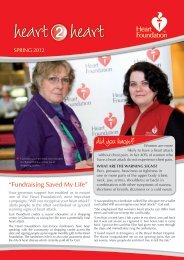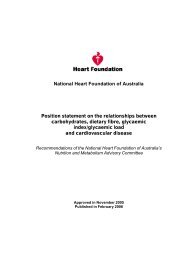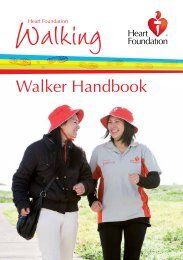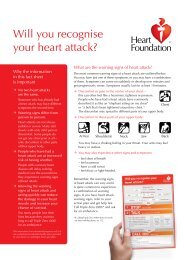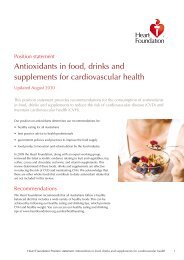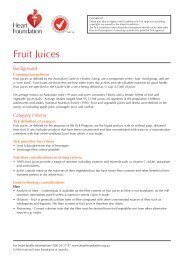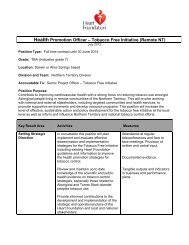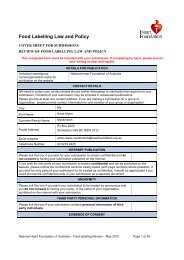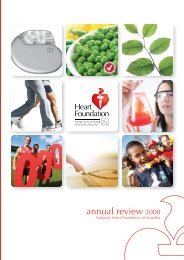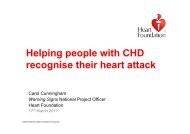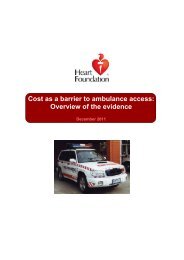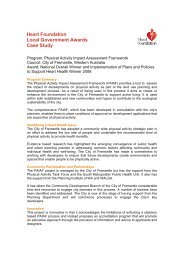Healthy by Design - National Heart Foundation
Healthy by Design - National Heart Foundation
Healthy by Design - National Heart Foundation
Create successful ePaper yourself
Turn your PDF publications into a flip-book with our unique Google optimized e-Paper software.
35 36<br />
Appendix A: further<br />
reading<br />
• Active Living Leadership, Robert Wood Johnson <strong>Foundation</strong>, USA. Available at<br />
www.leadershipforactiveliving.org. Viewed February 2004.<br />
• Barton H, 2003, ‘<strong>Healthy</strong> Cities’, Urban <strong>Design</strong> Quarterly, Spring 2003, Issue 86,<br />
pp.15-16.<br />
• Bauman A, Bellew B, Vita P, Brown W, Owen N, 2002. Getting Australia active:<br />
towards better practice for the promotion of physical activity, <strong>National</strong> Public<br />
Health Partnership, Melbourne, Australia, March 2002.<br />
• Bicycle Victoria, Cycle friendly suburbs: practical tools and guidelines for<br />
building bike networks, paths and bike lanes. Available at www.bv.com.au.<br />
Viewed February 2004.<br />
• Deakin University and Parks Victoria, 2002. <strong>Healthy</strong> parks healthy people: the<br />
health benefits of contact with nature in a park context: a review of current<br />
literature. Available at www.parks.vic.gov.au. Viewed April 2004.<br />
• Department of Human Services, 2001. Environments for health: Municipal public<br />
health planning framework, Department of Human Services, Melbourne.<br />
• Department of Infrastructure, 2002. Melbourne 2030: Planning for sustainable<br />
growth, Department of Infrastructure, Melbourne. Available at<br />
www.melbourne2030.vic.gov.au. Viewed April 2004.<br />
• Garrard J, Lewis B, Keleher H, Tunny N, Burke L, Harper S & Round R, 2004.<br />
Planning for healthy communities: reducing the risk of cardiovascular disease<br />
and type 2 diabetes through healthier environments and lifestyles, Victorian<br />
Government Department of Human Services, Melbourne.<br />
• King J, 2003. ‘<strong>Healthy</strong> Streets’, Urban <strong>Design</strong> Quarterly, Spring 2003, Issue 86,<br />
pp.17-18.<br />
• VicHealth, 2002. Leading the Way: Councils creating healthier communities,<br />
VicHealth.<br />
• Local Government Community Services Association of South Australia, 2002.<br />
Making it real: a resource for community consultation, resource guide and<br />
website. Available at www.lgcsasa.asn.au. Viewed February 2004.<br />
• <strong>National</strong> <strong>Heart</strong> <strong>Foundation</strong> of Australia (SA Division), 1999. Supportive<br />
environments for physical activity: guidelines for local government, <strong>National</strong><br />
<strong>Heart</strong> <strong>Foundation</strong> of Australia.<br />
• Tolley R, 2003. Providing for pedestrians: principles and guidelines for improving<br />
pedestrian access to destinations and urban spaces, Department of Infrastructure,<br />
Melbourne, July 2003.<br />
Appendix B:<br />
supporting<br />
research<br />
Research provides a strong case for the promotion and development of<br />
environments that are conducive to active living. The sources detailed below<br />
document a variety of design factors found to influence the extent to which people<br />
walk and cycle in their local neighbourhood.<br />
These factors include:<br />
• aesthetic features (articles 1, 2, 4, 5, 7-9, 11)<br />
• proximity to shops and local facilities (articles 1, 3-8, 11, 13, 14)<br />
• footpath widths, presence of paths and streets designed for walking (articles 3,<br />
4, 6-8, 10, 11)<br />
• continuous routes (particularly for cyclists) (article 11)<br />
• a safe environment (including crossings and lighting, being seen) (articles 1, 5,<br />
11, 14)<br />
• higher density, compact neighbourhoods (articles 2, 5, 6, 10)<br />
• mixed use zoning (articles 5, 6, 10)<br />
• convenience and accessibility (articles 1, 4, 5, 12)<br />
• traffic speeds and volume (articles 4, 11, 14)<br />
• traffic control measures (article 4)<br />
• access to public transport (article 11).<br />
(01) Ball K, Bauman A, Leslie E, Owen N. Perceived environmental aesthetics and<br />
convenience and company are associated with walking for exercise among<br />
Australian adults. Preventive Medicine. 2001; 33: 434-440.<br />
(02) Berrigan D, Troiano R. The association between urban form and physical<br />
activity in U.S. adults. American Journal of Preventive Medicine 2002; 23<br />
(2S): 74-79<br />
(03) Booth ML, Owen N, Bauman A, Clavisi O, Leslie E. Social-cognitive and<br />
perceived environment influences associated with physical activity in older<br />
Australians. Preventive Medicine. 2000; 31: 15-22.<br />
(04) Corti B, Donovan R, D’Arcy C, Holman J. Factors influencing the use of<br />
physical activity facilities: results from qualitative research. Health Promotion<br />
Journal of Australia. 1996; 6(1): 16-21.<br />
(05) Craig C, Brownson R, Cragg S, Dunn A. Exploring the effect of the<br />
environment on physical activity: a study examining walking to work.<br />
American Journal of Preventive Medicine. 2002; 23(2S): 36-43.<br />
(06) Ewing R, Schmid T, Killingsworth R, Zlot A, Raudenbush S. Relationship<br />
between urban sprawl and physical activity, obesity, and morbidity. American<br />
Journal of Health Promotion. 2003; 18(1): 47-57.<br />
(07) Giles-Corti B, Donovan R. Socioeconomic status differences in recreational<br />
physical activity levels and real and perceived access to a supportive physical<br />
environment. Preventive Medicine. 2002; 35: 601-611.<br />
(08) Giles-Corti B, Macintyre S, Clarkson J, Pikora T, Donovan R. Environmental<br />
and lifestyle factors associated with overweight and obesity in Perth,<br />
Australia. American Journal of Health Promotion. 2003; 18(1): 93-102.<br />
(09) Humpel N, Owen N, Leslie E. Environmental factors associated with adults’<br />
participation in physical activity. American Journal of Preventive Medicine.<br />
2002; 22(3): 188-199.<br />
(10) King A, Stokols D, Talen E, Brassington G, Killingsworth R. Theoretical<br />
approaches to the promotion of physical activity. American Journal of<br />
Preventive Medicine. 2002; 23(2S): 15-25.<br />
(11) Pikora T, Giles-Corti B, Bull F, Jamrozik K, Donovan R. Developing a<br />
framework for assessment of the environmental determinants of walking and<br />
cycling. Social Science & Medicine. 2003; 56: 1693-1703.<br />
(12) Powell K, Martin L, Chowdhury P. Places to walk: convenience and regular<br />
physical activity. American Journal of Public Health. September 2003, Vol 93,<br />
No.9: 1519-1521.<br />
(13) Sallis J, Kraft K, Linton L. How the environment shapes physical activity: a<br />
transdisciplinary research agenda. American Journal of Preventive Medicine.<br />
2002; 22(3): 208.<br />
(14) Timperio A, Crawford D, Telford A, Salmon J. Perceptions about the local<br />
neighbourhood and walking and cycling among children. Preventive Medicine.<br />
2004; 38: 39 - 47.



